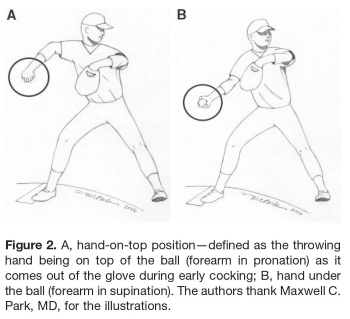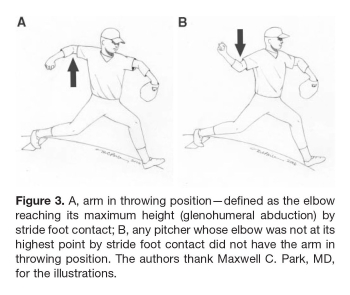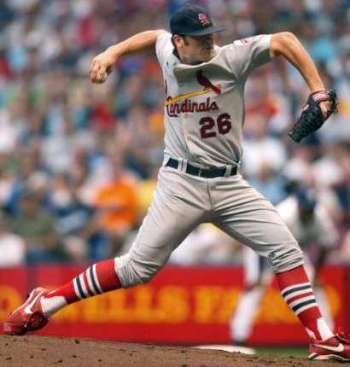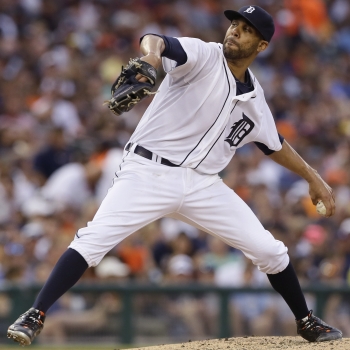 I believe a significant proportion of injuries to pitchers' elbows and shoulders injuries are the result of a set of mechanical flaws that I refer to individually as the Inverted W, Inverted V, and Inverted L and collectively as the inverted arm actions.
I believe a significant proportion of injuries to pitchers' elbows and shoulders injuries are the result of a set of mechanical flaws that I refer to individually as the Inverted W, Inverted V, and Inverted L and collectively as the inverted arm actions.
However, the thing to understand is that the inverted arm actions don't directly create problems.
Rather, in my experience the inverted arm actions tend to create a Timing problem, which is the root cause of many of the injuries that you so often see in pitchers with inverted arm actions.
For a better fundamental understanding of the pitching motion, my Revised Baseball Pitching Cycle breaks the pitching delivery up into (more) objectively-defined stages. My analysis of the Problems with the NPA's Sequence of Critical Events discusses how a number of misconceptions have affected it.
My work is based on my reading literally every study I can find, the most important of which include...
The Science Behind The Epidemic
Because a major point of criticism of my work has been that it lacks scientific backing, let's go over the literature and its relevance to my observations.
Most Relevant Studies
These studies are particularly relevant to the claims I make.
In 2010 Dr. Weimi Douoguih, Medical Director for MedStar Sports Medicine and Medical Director for the Washington Nationals, commissioned a study that led to...
...that looked at my claims with respect to the Inverted W. He did this by looking at the pitching mechanics of major league pitchers during the 2010 and 2011 seasons and comparing their pitching mechanics, arm action, and timing to their injury histories. This study found that there is merit to the idea that the Inverted W is problematic.
I give some background, and review the results of the study, in my review of the Douoguih study of the Inverted W and Timing.
Dr. Cynthia LaBella presented a study to the AAOS
that very directly relates to the topics I discuss, and in particular the core problem with the Inverted W, Inverted L, and Inverted V. The most relevant portion of this study is...
Paired t-tests compared the pain group to the no-pain group for the following three variables that had the greatest difference in mean scores between groups:
- Internal shoulder rotation at initiation of external shoulder rotation in stride.
- Shoulder elevation at initiation of elbow extension in stride.
- Average shoulder elevation from start of pitching cycle to time of maximum shoulder elevation.
...The pain group had greater internal shoulder rotation at the initiation of external rotation in the stride.
When LaBella talks about internal rotation and delayed external rotation, she is talking about timing problems that are caused by the inverted arm actions.
Internal rotation = Inverted arm action.
The inverted arm actions by definition create more internal rotation than is typical and delay the onset of external rotation. LaBella's study indicates that prolonged internal rotation increases the likelihood that pitchers will experience problems.
Other Relevant Studies
Other studies that are relevant to this topic are...
Aguinaldo (2007) Effects of Upper Trunk Rotation on Shoulder Joint Torque Among Baseball Pitchers of Various Levels
Professional pitchers demonstrated the least amount of rotational torque (p = .001) among skeletally mature players, while exhibiting the ability to rotate their trunks significantly later in the pitching cycle, as compared to other groups (p = .01). It was concluded that the timing of their rotation was optimized as to allow the throwing shoulder to move with decreased joint loading by conserving the momentum generated by the trunk. These results suggest that a specific pattern in throwing can be utilized to increase the efficiency of the pitch, which would allow a player to improve performance with decreased risk of overuse injury...The current study demonstrated that pitchers who rotated their torsos later in their delivery exhibited less shoulder internal rotation torque...The probability of inducing resultant loads, higher than the elastic strengths of the shoulder structures constraining the joint, increases as upper extremity muscular contributions augment the joint angular velocity in an attempt to compensate for an early onset of trunk rotation...In this study, the shoulder internal rotation torque,which counters this movement, peaked at maximum external rotation. Hence, early trunk rotation most likely caused a shoulder lag that led to an increase in internal rotation torque observed in the less experienced throwers. Based on our findings, it would seem that potentially detrimental rotational torques could be minimized if trunk rotation was delayed so as to allow the shoulder joint to “catch up” with segmental body motion.
Aguinaldo (2009) Correlation of Throwing Mechanics With Elbow Valgus Load in Adult Baseball Pitchers
The study starts off with this hypothesis.
Hypothesis: The onset of trunk rotation, with other biomechanical variables that define sequential body motion, will significantly predict elbow valgus loading.
In other words, their hypothesis is that elbow valgus loading, which is a specific type of force on the elbow that leads to the need for TJ surgery, is related to a pitcher's timing (aka the onset of trunk rotation). This is relevant because the Inverted W can change the timing of the movements of the pitcher's arm relative to the onset of trunk rotation. That in turn can changes the amount of stress on the elbow (and IMO the shoulder). In other words...
- Good timing = Pitching Arm Side (PAS) forearm vertical and at 90 degrees of external rotation when trunk rotation starts which means less forceful external rotation which means less valgus stress.
- Bad timing = PAS forearm not vertical and at much less than 90 degrees of external rotation when trunk rotation starts which means more forceful external rotation which means more valgus stress.
The results of the study included...
Results: Players who initiated trunk rotation before front-foot contact had significantly higher elbow valgus torques than did those who rotated afterward (P = .02).
In other words, players who had major timing problems were more vulnerable to elbow problems. That doesn't say anything about the Inverted W per se, but it does say there's a relationship between timing problems and the load/stress on the elbow.
In the case above, the problem is that the pitcher starts rotating their shoulders too early, likely before their arm is up and in the correct position. The Inverted W does the same thing; it delays the arm in getting up into the correct position and makes it late.
Results: Reduced elbow valgus torques were associated with increased elbow flexion (P = .01)...Similarly, a higher elbow flexion angle at the
instant of peak elbow valgus was associated with reduced magnitudes of elbow valgus torque.
So bending/flexing the elbow helps to protect it. This likely explains why Mark Prior, for all of his problems, never needed Tommy John surgery. It could also explain the lack of elbow problems in short-armers like Greg Maddux and Roger Clemens.
Although there were no significant differences in demographics or ball velocity between groups (P = .10), the pre-foot contact players exhibited significantly more elbow valgus torque (59 ± 27 Nm) than the post-foot contact players did (42 ± 29 Nm, P = .02).
So, again, timing matters in terms of the load on the elbow.
Fourteen pitchers displayed a sidearm delivery, exhibiting an average elbow valgus torque of 66 ± 24 Nm, which was significantly higher (P = .02) than that of those who threw with the more common overhand, or "3/4," slot position (46 ± 29 Nm).
This is VERY interesting. Lots of pitching coaches think throwing sidearm is worse for the arm than throwing from a higher arm slot. I've pooh-poohed the idea that throwing sidearm is bad because I've never seen a study back up that notion.
Until now.
Pitchers who rotated their trunks (ie, squared up) later in the pitching cycle appeared to have reduced magnitudes of elbow valgus torque.
I believe that this is because it gives the arm more time to get more vertical. However, the Inverted W interferes with this process and causes the arm to get up late.
In this study, pitchers who initiated trunk rotation before front-foot contact exhibited significantly more elbow valgus torque than did those who rotated their trunks afterward.
In other words, and again, pitchers who start rotating their shoulders before their Pitching Arm Side forearms are up and at 90 degrees of external rotation -- which is what happens during the Inverted W -- are more vulnerable to elbow problems.
This study only indirectly talks about the Inverted W, but it helps to bolster my case. This case demonstrates that timing problems increase the load on the elbow. Since the Inverted W can create a timing problem, it can increase the load on the elbow.
Anz (2010) Correlation of Torque and Elbow Injury in Professional Baseball Pitchers
One basis of the theory that the Inverted W is related to shoulder and elbow problems is the idea that the Inverted W causes a timing problem and that that timing problem increases the load on the elbow and the shoulder by delaying and increasing the amount of external rotation of the Pitching Arm Side upper arm. This study provides evidence that increased levels of load on the elbow and shoulder are problematic.
Pitchers experiencing higher levels of elbow valgus torque and shoulder external rotation torque throughout the pitching motion are more likely to suffer elbow injury than pitchers with lower levels of torque.
This study also notes that there is an established relationship between pitching mechanics and the load on the elbow and the shoulder.
Subtle differences in mechanics (e.g., onset of trunk rotation, maximal shoulder external rotation, elbow flexion at ball release) have been shown to produce differences in the torques and forces experienced at the elbow and shoulder throughout the pitching motion.
Park & Ahmad (2004) Dynamic Contributions of the Flexor-Pronator Mass to Elbow Valgus Stability
As I explain in my piece on Premature Pronation, the muscles of the forearm have the ability to protect the elbow by absorbing some of the load that would otherwise be born by the UCL.
Thus The Epidemic?
These studies blindly accept the conventional wisdom about proper pitching mechanics. In my experience, and based on the results of numerous studies, what they say is correct is problematic and what they say is incorrect is much better for the elbow and/or the shoulder. As a result, they make me wonder whether, and to what degree, they are contributing to the pitcher injury and Tommy John surgery epidemic.
I post this study first, not because it's that good, but because it's that bad; it contains one of the most mind-bottling paragraphs I have ever read and is the reason for the question mark in my piece Proper Pitching Mechanics?

Thus the Epidemic?
If something reduces the risk of elbow and shoulder pain, and doesn't seem to have any negative impact on velocity, then how exactly is it a flaw?
Rarely is a lack of insight so clearly telegraphed.
In fact, you could write a few chapters of a pitching injury prevention book, if not an entire pitching injury prevention book, around just this paragraph, and I'm doing just that with Dominant & Durable.
David (2009) shares the same flaw as Lyman (2002); it accepts without question the conventional wisdom about pitching mechanics.These claims are backed up biomechanical models, but not by longitudinal health studies. That, in my opinion, is a major flaw because many things they say run counter to the history of the game of baseball.
Video analysis of the youth pitchers revealed that correctly performing hand-on-top position was associated with lower HIRT, lower EVL, and higher pitching efficiency. We believe that the hand-on-top position initiates early shoulder abduction while delaying humeral external rotation because when the forearm is pronated, the humerus remains internally rotated. This causes the shoulder to abduct while delaying humeral external rotation (Figure 2A).
Here's the problem.
First, I am extremely skeptical of measures of pitching efficiency; too often they result in overloading the arm.
Second, the study says the hand-on-top position is preferred, in my opinion despite, but in their opinion because it results in what I call Premature Pronation...
Hand-on-top position: Performance was defined in terms of whether the throwing hand was on top of the ball (forearm in pronation; correct, Figure 2A) as it comes out of the glove during early cocking or under the ball (forearm in supination; incorrect, Figure 2B).
...presumably solely because it results in what the study says is a more efficient delivery in which external rotation is delayed. While that may indeed make the delivery more efficient, LeBella 2011 (see below) links delayed external rotation, and prolonged internal rotation, with an increased incidence of pain in young pitchers.
Delayed glenohumeral abduction and early external rotation (hand-under-ball position; Figure 2B) may lead to the arm’s being “late” in the pitching motion;
This sentence is problematic because they get the terminology backwards; an arm that externally rotates too much too soon is too early, not too late. As a result, their conclusions don't hold.
(E)xcessive horizontal abduction can result as the torso unwinds and the arm is not properly positioned. This extreme horizontal abduction has been called hyperangulation, and it has been implicated as a contributor to injury in the throwing shoulder (Figure 5).
The next sentence is at least illogical because, in my experience, it is easier to horizontally abduct the arm when it is internally rotated (forearm flat or pointing down) than when it is externally rotated (forearm up).
We believe that the hand-on-top position initiates early shoulder abduction while delaying humeral external rotation because when the forearm is pronated, the humerus remains internally rotated. This causes the shoulder to abduct while delaying humeral external rotation (Figure 2A)
As for my old nemesis the
Inverted W, if you look at pictures of what is being advocated -- abduction combined with prolonged internal rotation -- what you see is a classic inverted arm position.

Davis 2009 Figure 2
This isn't automatically bad. As you can see in Figure 2, the stride foot is still well up in the air. However, if this position is held for too long, it will likely cause a Timing problem.
The most troubling this in this study has to do with Parameter 3...
Parameter 3—Arm in throwing position: Correct performance was defined as the elbow reaching its maximum height (glenohumeral abduction) by stride foot contact (Figure 3A). Any pitcher whose elbow was not at its highest point by stride foot contact did not have the arm in throwing position (incorrect, Figure 3B).
While the words are concerning, the illustration of this parameter is damning.

Davis 2009 Figure 3
As you can see in Figure 3, the pitcher is at Stride Foot Contact and their arm is at best flat and at 0 degrees of internal rotation and more likely internally rotated.
That is the definition of a Timing problem.
And this study is saying that is correct.
Fortunately for them, very few of the pitchers in the study performed Parameter 3 "correctly." Otherwise they would end up like the other victims of Flat Arm Syndrome or, worse, Anthony Reyes and his Inverted W and huge Timing problem.

Anthony Reyes
I don't doubt that this movement may be more efficient in theory, but in my experience it ignores the limits of the human body. In my opinion, that is a big reason why pitchers are increasingly breaking down; their pitching mechanics are more efficient than their bodies can tolerate.
Attempts to close the gap between the efficiency of the pitching mechanics and the capabilities of the body, but the experiences of pitchers like Steve Delabar -- who as of 2015 had one good year followed by two off years -- make me wonder whether these extreme conditioning efforts will be successful.
Video analysis in the adolescent group showed that leading with the hips was associated with higher nHIRT and nEVL, as well as lower pitching efficiency.
Finally, I believe the quote above points to what may be the key problem with this paper; the model is wrong, with the sign of the measure of pitching efficiency being backwards. If you study the history of the game, it quickly becomes obvious that velocity is linked with leading with the hips.

David Price
As a result, to label that a less efficient movement brings into question the entire evaluative framework.
In general, I believe the current emphasis on models of loads, rather than seasonal or longitudinal measures of pain and injuries, is problematic. When I see a model get the sign wrong when it comes to one of the easiest to verify movements, I have to question every study that relies on models rather than direct observations.
Tying it all Together
In summing up why I believe certain cues and drills are problematic, the place to start is with this quote from Davis 2009...
(W)hen the forearm is pronated, the humerus remains internally rotated.
Of course, the forearm being pronated to early on in the delivery, and into or after Foot Plant in the worst case, is a flaw that I call Premature Pronation. Davis 2009 implies that this is good, but LaBella 2011 suggests it is bad...
The pain group had greater internal shoulder rotation at the initiation of external rotation in the stride.
Douoguih 2015 also found that even low levels of external rotation, much less internal rotation, at the start of trunk rotation -- what I call a Timing problem and, in more severe cases, Flat Arm Syndrome -- increased the risk of surgery...
Early trunk rotation was defined as trunk rotation before the stride foot hit the ground and occurrence of non-vertical arm position at initiation of trunk rotation...The presence of early trunk rotation was associated with significantly increased risk of surgery.
Finally, Lyman 2002 found what would seem to be the holy grail -- ways of reducing the incidence of elbow and shoulder pain with no apparent impact on velocity -- but inexplicably labeled these injury-reducing movements as flaws...
(T)wo mechanical flaws, backward lean in the balance position and early hand separation, correlated with a decreased risk of elbow pain. Two other flaws, a long arm swing and arm ahead of the body at the time of ball release, correlated with a decreased risk of shoulder pain.
Notes
[1] I explain how I noticed the link between the Inverted W, rushing, and injury problems in my
Inverted W FAQ.
[2] The Inverted W is the moral equivalent of running a car engine past the red line. It works. For a while.